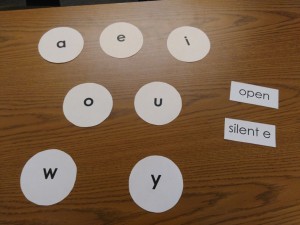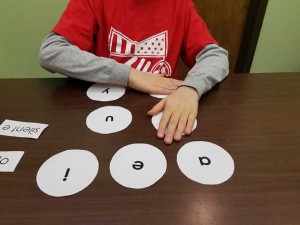Looking for a kinesthetic approach to practicing long vowels with vowel teams? I had been working with one of my students on “walking” vowel teams (two vowels go walking, the first one does the talking). He did fine with reading them, but when it came to saying “what spells” the long vowel sound, he was really struggling with the two-letter vowel teams. There was lots of guessing (ou? oi?) Keyword pictures weren’t helping much either, as he couldn’t remember how to spell boat, or snow or toe or…
This student is very much a kinesthetic learner, so I wanted to come up with something that would help him physically feel the various spellings. I decided to try what I called Vowel Team Twister, based loosely on the Twister game. We don’t have much space to move around in our rooms, so I created a table-top version. There’s one circle with each vowel letter on it (a, e, i, o, u, w and y) and two bonus squares that say “open” and “silent e”. Place them in alphabetical order on the table…they should always stay in the same spot, so you might want to put a loop of tape on the back to keep them from moving…with the open and silent e squares to the right:
To practice specific vowel teams, have the student place their left hand on the first letter of the vowel team, and then place their right hand on the second letter of the vowel team. For instance, you would ask your student to show you “a like in train” and they would put their left hand on “a” and their right hand on “i”.) For some combinations like “ea”, they will have to cross their hands (hence the “twister”!). For “ee”, have them place their left hand on e, then their right hand on top of their left. Ee is a vowel team my student was having a hard time remembering, and having the “funny” hand placement really seemed to help him get it.
Once they have the hang of doing the various vowel teams, this activity can be extended to practice “what spells” (Say “a”, what spells “a”…”a when it’s open”, “a silent e”, “a-i”, “a-y”). Be sure to have the student place their right hand on the “open” square when it’s “a when it’s open”, and on the “silent e” square for silent e. This helps reinforce the fact that there are different types of syllables that make the long vowel sound, and that for most of the long vowel sounds, open and silent-e are the first two options.
Here’s a demonstration of what it looks like:
I’ve attached vt-twister.pdf template here if you’d like to make your own Vowel Team Twister and give it a try!


